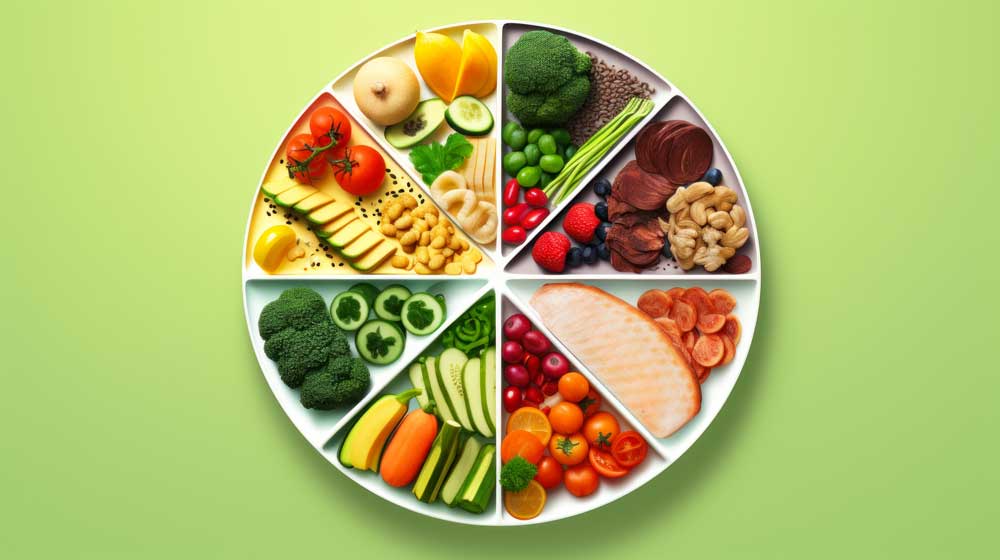8 Ways To Focus on Nutrition in Your Diet

March 21, 2024
We know that what we eat matters. Eating a balanced, nutritious diet can be key to good health. This can be difficult in practice, however.
“What we eat plays a huge role in our health, which I think most people are somewhat aware of. But people who have healthier eating patterns tend to live longer with a lower risk of serious health problems,” says Heather Gurniak, a certified health and wellness coach and health promotions coordinator at BlueCross BlueShield of South Carolina.
People with chronic conditions can choose healthy food options to help manage the disease and prevent complications.
“Eating a balanced diet has many health benefits apart from just weight loss. A healthy diet can strengthen your immune system, give you more energy, prevent many chronic health conditions, lower your risk of complications related to health conditions, and even protect against cancer,” says Lauran Kerrison, a registered nurse and managed care coordinator at BlueCross.
So how can you make sure you are getting the nutrition you need?
Start Small
Don’t get overwhelmed. Starting with one or two small changes can help you stick to healthy habits.
- Add nutrient-dense foods like fruits and vegetables.
- Limit calorie-dense foods like fast food.
- Drink plenty of water.
- Minimize processed foods.
“One tip is to shop around the perimeter of the grocery store to avoid the middle aisles,” Kerrison says.
Get Enough Fiber
Dietary fiber* is part of the food that our bodies can’t digest or absorb. It passes through your stomach.
A high-fiber diet helps normalize bowel movements and maintains bowel health. It can control blood sugar levels and lower cholesterol levels.
“We don't get enough fiber. We should be eating 30 to 35 grams a day for the typical adult. Most of us get less than 10 grams a day. Focus on high fiber foods in our meals,” says Gurniak.
You can find fiber in whole-grain products, fruits, vegetables, beans and other legumes, and nuts and seeds.
Eat This
Fish is one of the healthiest options. It is loaded with nutrients and a source of omega-3 fatty acids. It has numerous health benefits*, including boosting brain function and lowering risk of heart attacks and strokes.
Other nutritionally dense foods include:
- Berries.
- Dark leafy greens.
- Nut butters.
- Almonds and other nuts.
- Avocados.
- Chia seeds.
Not That
Limit the processed foods*. This is where added salt and sugar sneak up on you. Often, they include additives and saturated fats that can be bad for your health.
This is where reading nutrition labels* can be key.
“Nutrition labels can help with making healthy choices,” Gurniak says. “They break down the nutrients and calories per serving so that you are able to make informed decisions about which foods to buy and which to avoid.”
Don’t Diet
Fad diets may work for short-term weight loss. But they can be difficult to maintain. Some may not be good for health and lead to nutrient deficiencies.
Before making any changes to your diet, discuss changes with your health care provider. When finding information online, look for trusted sources such as the U.S. Department of Agriculture’s (USDA’s) Nutrition.gov*. The MyPlate website* is also a good resource for understanding how to fill your plate.
Portion Control
Healthy eating is all about balance. Pay attention to the portion sizes* of your food. Follow the recommended serving size for each food and food group.
“If giving up fast food or junk food is not achievable for you, focus on limiting your intake of these foods,” Gurniak says. “When you eat out, try to choose healthy options from the menu like grilled instead of fried and a salad or fruit for your side.”
Kerrison suggests reviewing the menu at restaurants beforehand. Make a plan for what to order.
Use smaller plates or bowls. Studies show that the size of the plate can impact how much food you eat. You can measure your food using the plate or your hand as a guide*.
A rough guide to help measure:
- Vegetables or salad — half a plate
- Quality protein — quarter of a plate
- Complex carbs — quarter of a plate
- High-fat foods — half a tablespoon
Focus on Food
Eating for health, not joy, can be important, Gurniak says.
“It’s a whole mindset,” she says.
Eat slowly. Thoroughly chew your food so that your brain has time to process when you are full. Avoid multitasking like watching TV while eating. This can lead to overeating.
Drink water* while you eat. It can help you pause while you eat to ensure you are full or not.
Don’t skip meals. Be sure to eat healthy snacks in between meals.
Try New Foods
Everyone has foods they don’t like. But there are ways to hide aspects of food you may not like.
Swap processed sweets like cakes, cookies and muffins for fruit or Greek yogurt. Swap chips with mixed nuts or crunchy vegetables dipped in hummus. Swap sweet drinks for sparkling water, green tea or kombucha.
“Pair vegetables with foods you already like,” says Kerrison. “Play with texture. If you hate mushy vegetables, try raw, shredded, roasted or stir-fried versions instead. Love crunchy foods? Try baked kale or beet chips. Add spectacular flavor with a little olive oil, garlic, a drizzle of balsamic vinegar, a squeeze of lemon or a dash of fresh herbs.”
Experiment with dry seasonings to discover new flavors. This helpful seasonal produce guide* from the USDA pairs vegetables with recipes.
*These links lead to third-party websites. Those organizations are solely responsible for the contents and privacy policies on their sites.
Healthy Swaps
Kerrison and Gurniak share a few ways to add nutritionally dense food to your daily meals.
- Use homemade, low sugar creamer instead of coffee creamer.
- One 13.5-ounce (400-milliliter) can of whole or reduced-fat coconut milk
- 1 tablespoon (15 milliliters) of maple syrup
- 1 teaspoon (5 milliliters) of vanilla extract
- Drink sparkling water, green tea or kombucha instead of soda.
- Try oatmeal, chia pudding or a yogurt parfait instead of sugary cereal.
- Choose a healthy or homemade granola bar.
- Try teas and coffee instead of energy drinks.
- Try whole grain, sprouted bread instead of white bread.
- Eat dried fruit or dark chocolate instead of candy.
Related Reading
 The Importance of Play
The Importance of Play
Children play a lot, but playing is important for all ages. It has many health benefits. We share some ways to add play into your life.
Read More 5 Heart Health Myths
5 Heart Health Myths
A health expert examines common misconceptions around heart health. Having a healthy cardiovascular system is important for overall health.
Read More How To Have a Healthy Gut
How To Have a Healthy Gut
The health of your gut can affect your overall health. A BlueCross expert answers questions about the importance of a healthy gut and how to have a good balance.
Read More


















